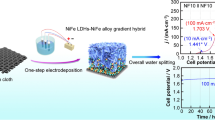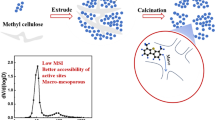Abstract
Exploiting functional characteristics of high-entropy boride materials is critical for extending their potential applications in harsh environments. Herein we develop high-entropy diboride (HEB2) nanoparticles with efficient catalytic performance by engineering their compositions. Based on the theoretical analysis of the lattice size difference and mixing enthalpy of HEB2 and the self-propagating combustion mode of the system, six different compositional HEB2 nanoparticles are synthesized via a facile, rapid, and low-cost combustion synthesis method. By engineering their compositions, we achieve the efficient catalytic ability of HEB2 nanoparticles in persulfate activation towards antibiotics removal, namely the highest tetracycline removal efficiency of 93.5%. Further investigations of the adsorption energy and the charge density difference of various adsorption sites via density functional theory confirm that the outstanding catalytic ability mainly originates from the Ti constituent rather than the high-entropy effect. In addition, a potential catalytic mechanism of HEB2 towards persulfate activation for antibiotics degradation is proposed based on the detected reactive oxygen species and the computational reaction energy barrier. This study not only provides theoretical basis for their component design in the efficient catalytic degradation of antibiotics, but also shows a promising application of HEB2 for removal of emerging contaminants from environmental water matrices.

摘要
开发高熵硼化物材料的功能特性对于拓宽其在极端环境中的潜 在应用至关重要. 为此, 本文通过调控材料的组分开发出具有高效催化 性能的高熵二硼化物(HEB2)纳米颗粒: 首先基于对HEB2的尺寸差异因 子、混合焓以及体系自蔓延燃烧模式的理论分析, 我们采用一种简 便、快速、低成本的燃烧合成方法合成了6种不同组分的HEB2纳米颗 粒; 然后, 通过对材料的组分进行调控实现了HEB2纳米颗粒活化过硫酸 盐降解抗生素的高效催化能力(四环素的最高去除效率可达93.5%). 不 同吸附位点的吸附能和差分电荷密度的第一性原理计算结果进一步证 实了HEB2优异的催化性能主要归因于Ti组元, 而非高熵效应. 此外, 基 于检测到的活性氧和计算的反应能垒, 我们提出了HEB2活化过硫酸盐 降解抗生素的潜在催化机理. 本研究不仅为HEB2高效催化降解抗生素 的组分设计提供了理论依据, 而且显示出HEB2在去除自然水体中新污 染物方面的潜在应用前景.
Similar content being viewed by others
References
Rost CM, Sachet E, Borman T, et al. Entropy-stabilized oxides. Nat Commun, 2015, 6: 8485
Ye B, Wen T, Nguyen MC, et al. First-principles study, fabrication and characterization of (Zr0.25Nb0.25Ti0.25V0.25)C high-entropy ceramics. Acta Mater, 2019, 170: 15–23
Wen T, Liu H, Ye B, et al. High-entropy alumino-silicides: A novel class of high-entropy ceramics. Sci China Mater, 2020, 63: 300–306
Ma M, Han Y, Zhao Z, et al. Ultrafine-grained high-entropy zirconates with superior mechanical and thermal properties. J Materiomics, 2023, 9: 370–377
Sarkar A, Velasco L, Wang D, et al. High entropy oxides for reversible energy storage. Nat Commun, 2018, 9: 3400
Gild J, Zhang Y, Harrington T, et al. High-entropy metal diborides: A new class of high-entropy materials and a new type of ultrahigh temperature ceramics. Sci Rep, 2016, 6: 37946
Liu D, Wen T, Ye B, et al. Synthesis of superfine high-entropy metal diboride powders. Scripta Mater, 2019, 167: 110–114
Wen Z, Meng H, Jiang S, et al. Non-equimolar (Hf,Zr,Ta,W)B2 high-entropy diborides enable superior oxidation resistance. Sci China Mater, 2023, 66: 3213–3222
Ye B, Wen T, Huang K, et al. First-principles study, fabrication, and characterization of (Hf0.2Zr0.2Ta0.2Nb0.2Ti0.2)C high-entropy ceramic. J Am Ceram Soc, 2019, 102: 4344–4352
Sarker P, Harrington T, Toher C, et al. High-entropy high-hardness metal carbides discovered by entropy descriptors. Nat Commun, 2018, 9: 4980
Ma M, Sun Y, Wu Y, et al. Nanocrystalline high-entropy carbide ceramics with improved mechanical properties. J Am Ceram Soc, 2022, 105: 606–613
Ma M, Hu X, Meng H, et al. High-entropy metal carbide nanowires. Cell Rep Phys Sci, 2022, 3: 100839
Csanádi T, Castle E, Reece MJ, et al. Strength enhancement and slip behaviour of high-entropy carbide grains during micro-compression. Sci Rep, 2019, 9: 10200
Ye B, Wen T, Liu D, et al. Oxidation behavior of (Hf0.2Zr0.2Ta0.2Nb0.2-Ti0.2)C high-entropy ceramics at 1073–1473 K in air. Corrosion Sci, 2019, 153: 327–332
Ye B, Wen T, Chu Y. High-temperature oxidation behavior of (Hf0.2Zr0.2Ta0.2Nb0.2Ti0.2)C high-entropy ceramics in air. J Am Ceram Soc, 2020, 103: 500–507
Wang F, Yan X, Wang T, et al. Irradiation damage in (Zr0.25Ta0.25-Nb0.25Ti0.25)C high-entropy carbide ceramics. Acta Mater, 2020, 195: 739–749
Chu Y, Yu R, He G, et al. Combustion synthesis of high-entropy carbide nanoparticles for tetracycline degradation via persulfate activation. Sci China Mater, 2022, 65: 3144–3149
Qin M, Yan Q, Wang H, et al. High-entropy monoborides: Towards superhard materials. Scripta Mater, 2020, 189: 101–105
Qin M, Yan Q, Wang H, et al. High-entropy rare earth tetraborides. J Eur Ceramic Soc, 2021, 41: 2968–2973
Ma M, Yang X, Meng H, et al. Nanocrystalline high-entropy hexaboride ceramics enable remarkable performance as thermionic emission cathodes. Fundamental Res, 2022, doi: https://doi.org/10.1016/j.fmre.2022.04.010
Yang X, Zhong Q, Liang S, et al. Global supply chain drivers of agricultural antibiotic emissions in China. Environ Sci Technol, 2022, 56: 5860–5873
Rodriguez-Narvaez OM, Peralta-Hernandez JM, Goonetilleke A, et al. Treatment technologies for emerging contaminants in water: A review. Chem Eng J, 2017, 323: 361–380
Tian M, Zhu Y, Chen Y, et al. Template-assisted self-activation of mesoporous carbon with active nitrogen/oxygen configurations for sustainable triboelectric nanogenerator powered electro-Fenton degradation. Nano Energy, 2021, 83: 105825
Tian M, Zhu Y, Zhang D, et al. Pyrrolic-nitrogen-rich biomass-derived catalyst for sustainable degradation of organic pollutant via a self-powered electro-Fenton process. Nano Energy, 2019, 64: 103940
Gao Y, Wang Q, Ji G, et al. Degradation of antibiotic pollutants by persulfate activated with various carbon materials. Chem Eng J, 2022, 429: 132387
Yun ET, Yoo HY, Bae H, et al. Exploring the role of persulfate in the activation process: Radical precursor versus electron acceptor. Environ Sci Technol, 2017, 51: 10090–10099
Li N, Ye J, Dai H, et al. A critical review on correlating active sites, oxidative species and degradation routes with persulfate-based antibiotics oxidation. Water Res, 2023, 235: 119926
Oh WD, Dong Z, Lim TT. Generation of sulfate radical through heterogeneous catalysis for organic contaminants removal: Current development, challenges and prospects. Appl Catal B-Environ, 2016, 194: 169–201
Kresse G, Furthmüller J. Efficiency of ab-initio total energy calculations for metals and semiconductors using a plane-wave basis set. Comput Mater Sci, 1996, 6: 15–50
Blöchl PE. Projector augmented-wave method. Phys Rev B, 1994, 50: 17953–17979
Perdew JP, Burke K, Ernzerhof M. Generalized gradient approximation made simple. Phys Rev Lett, 1996, 77: 3865–3868
Heyden A, Bell AT, Keil FJ. Efficient methods for finding transition states in chemical reactions: Comparison of improved dimer method and partitioned rational function optimization method. J Chem Phys, 2005, 123: 224101
Jiang QG, Ao ZM, Li S, et al. Density functional theory calculations on the CO catalytic oxidation on Al-embedded graphene. RSC Adv, 2014, 4: 20290–20296
Wen T, Ye B, Liu H, et al. Formation criterion for binary metal diboride solid solutions established through combinatorial methods. J Am Ceram Soc, 2020, 103: 3338–3348
Moore JJ, Feng HJ. Combustion synthesis of advanced materials: Part I. Reaction parameters. Prog Mater Sci, 1995, 39: 243–273
Su X, Fu F, Yan Y, et al. Self-propagating high-temperature synthesis for compound thermoelectrics and new criterion for combustion processing. Nat Commun, 2014, 5: 4908
Ye B, Fan C, Han Y, et al. Synthesis of high-entropy diboride nano-powders via molten salt-mediated magnesiothermic reduction. J Am Ceram Soc, 2020, 103: 4738–4741
Tian M, Zhang D, Wang M, et al. Engineering flexible 3D printed triboelectric nanogenerator to self-power electro-Fenton degradation of pollutants. Nano Energy, 2020, 74: 104908
Liu CS, Shih K, Sun CX, et al. Oxidative degradation of propachlor by ferrous and copper ion activated persulfate. Sci Total Environ, 2012, 416: 507–512
Zhu S, Li X, Kang J, et al. Persulfate activation on crystallographic manganese oxides: Mechanism of singlet oxygen evolution for non-radical selective degradation of aqueous contaminants. Environ Sci Technol, 2019, 53: 307–315
Lee J, von Gunten U, Kim JH. Persulfate-based advanced oxidation: Critical assessment of opportunities and roadblocks. Environ Sci Technol, 2020, 54: 3064–3081
Acknowledgements
This work was supported by the National Key Research and Development Program of China (2021YFA0715801), the National Natural Science Foundation of China (52122204, 51972116, and 52072381), and Guangzhou Basic and Applied Basic Research Foundation (202201010632).
Author information
Authors and Affiliations
Contributions
Chu Y conceived and designed this work. He G, Yu R, Li J, and Deng S performed the synthesis and characterization. Sun X and Dong H performed the test experiments. Liu Y performed the first-principles calculations. All authors analyzed the data. Chu Y, Yu R, Liu Y, and Dong H wrote the manuscript. All authors commented on the manuscript.
Corresponding authors
Ethics declarations
The authors declare that they have no conflict of interest.
Additional information
Supplementary information
Supporting data are available in the online version of the paper.
Renwang Yu is currently a Master student at South China University of Technology, Guangzhou, China. His research interests focus on combustion synthesis of high-entropy diboride ceramic nanopowders.
Yiwen Liu is currently a Master student at South China University of Technology, Guangzhou, China. Her research interests focus on the oxidation of high-entropy non-oxide ceramics by first-principles calculations.
Gang He is an associate professor at Tianjin University of Technology, Tianjin, China. He received his PhD degree in materials science from the University of Chinese Academy of Sciences in 2015. From Jul. 2015 to Dec. 2021, He was a research associate at the Technical Institute of Physics and Chemistry, Chinese Academy of Sciences. His current research interests include non-oxide ceramic powders, transparent ceramics, and combustion synthesis technology.
Heng Dong is an associate professor at Nankai University, Tianjin, China. She received her PhD degree in environmental engineering from Nankai University in 2013. From Sep. 2019 to Sep. 2020, she worked at the University of California, Berkeley as a visiting scholar. Her current research focuses on advanced oxidation process for water/ wastewater treatment.
Yanhui Chu is currently a professor at South China University of Technology, Guangzhou, China. He received his PhD degree from Northwestern Polytechnical University in 2016. From Jan. 2014 to Sep. 2015, he was as a visiting scholar at Harvard University. His current research interest mainly focuses on the design, modeling and fabrication of high-entropy ceramics.
Rights and permissions
About this article
Cite this article
Yu, R., Liu, Y., Sun, X. et al. Composition engineering of high-entropy diboride nanoparticles for efficient catalytic degradation of antibiotics. Sci. China Mater. 66, 3582–3591 (2023). https://doi.org/10.1007/s40843-023-2496-5
Received:
Accepted:
Published:
Issue Date:
DOI: https://doi.org/10.1007/s40843-023-2496-5




